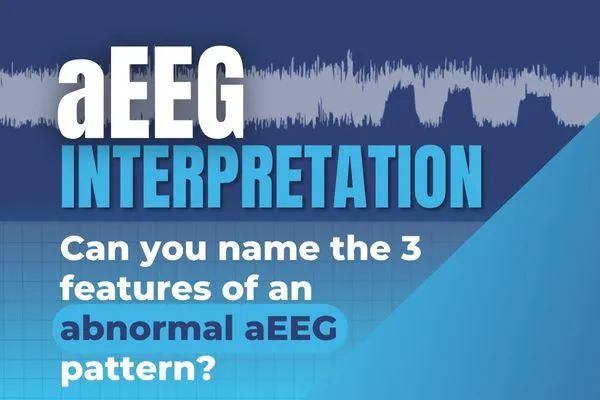
3 features of a BAD aEEG
When reading aEEG in the NICU you need to quickly assess the pattern and determine if it is normal, or abnormal.
Abnormal aEEG patterns are always troublesome and can be highly predictive of severe brain injury or dysfunction.
In this week's blog I'll be sharing how to identify abnormal aEEG patterns using a quick and easy algorithm.
The most common features of an abnormal or an ill aEEG using this 3 part algorithm - I L L.
Let's review each of these 3 features in more detail:
I - Intermittent Uprising
L- ?
L - ?
1. Intermittent uprisings in the aEEG band
The first and most significant indicator of abnormal brain activity is intermittent uprisings, which are seizures.
Seizures can manifest in various forms, but the typical pattern consists of a rounded archway that disrupts the aEEG band on the monitor screen.
As the seizure progresses, the lower margin of the voltage begins to rise, followed by an increase in the upper amplitude. The seizure becomes more rhythmic, causing the differential between the voltages to decrease, resulting in a compression or thinning of the aEEG band.
Therefore, when assessing aEEG for signs of seizures, one should look for an increase in the upper and lower margins, and a narrowing of the bandwidth.

Artifact Validation and Rhythmic Patterns
After identifying the features of seizures on the aEEG waveform, it's crucial to validate these findings by reviewing the raw EEG pattern to look for common artifacts (like movement and noise) and for evidence of a true rhythmic pattern that might confirm your suspicions of epileptic activity.
First start by reviewing any "marked events" noted by staff. These are usually identified as colored lines on the screen. Note things like feedings, cares, suctioning, handling, and infant movement or comforting patting.
Next you can "open" or decompress the EEG that formed the aEEG. Look for the presence or absence of artifacts should be examined. Artifacts can include movements, muscle activity, respirations, ECG and other equipment in the area.
To confirm epileptiform or seizure activity, look for rhythmic patterns in the raw EEG. A seizure is defined as a rhythmic pattern lasting more than 10 seconds. By reviewing the EEG for rhythmicity, one should be able to predict the subsequent activity on the screen. Intermittent uprisings are a clear indication of an issue with brain function, even if the background pattern appears normal.
I - Intermittent Uprising
L- Lack of sleep wake cycling
L - ?
2. Lack of Sleep-Wake Cycling
For patients in the NICU, sleep-wake cycling is expected, even as early as 28 weeks. In term babies, a well-regulated pattern of sleep-wake cycling is characterized by a robust thin-thick pattern (like the pattern below).

Lack of sleep-wake cycling can occur due to various reasons. Medications are a common cause, followed by chronic hypoxia, especially in cardiac babies with low mixed oxygen saturation levels. Loss of sleep-wake cycling indicates a brain's intolerance to hypoxia, and additional measures, such as monitoring brain saturation with NIRS (near infrared spectroscopy), may be necessary.
I - Intermittent Uprising
L- Lack of sleep wake cycling
L - Loss of continuous background patterns
3. Loss of continuity in the aEEG band
The third aspect to consider is the loss of continuous activity. As babies approach 34 to 36 weeks, continuous normal voltage should be observed in aEEG, with the upper margin above 10 and the lower margin above five. However, when there is a lack of continuous activity, an excessively discontinuous pattern emerges, sometimes consisting of a mixed pattern of bursts and suppression. This indicates a brain injury or other severe abnormality.

When analyzing aEEG patterns, it's essential to consider the gestational age of the infant.
As gestational age increases, continuous activity and sleep-wake cycling become more robust.
However, it's important to note that a preterm baby's aEEG pattern may differ from that of a term baby, even though it is not necessarily abnormal. The expectation is that aEEG will become more continuous with time as the brain matures.
Understanding these features is essential for accurate interpretation of aEEG at the bedside in the NICU. So, the next time you are standing at the bedside reviewing an aEEG pattern -- look out for these three signs of an abnormal aEEG.
I - Intermittent Uprising
L- Lack of sleep wake cycling
L - Loss of continuous background patterns
If you want to learn more about aEEG, you can:
Subscribe to our YouTube Channel
Download our free E-Book: 7-Steps to Read Any aEEG
Register for our online, and on demand, aEEG Mastery Course
